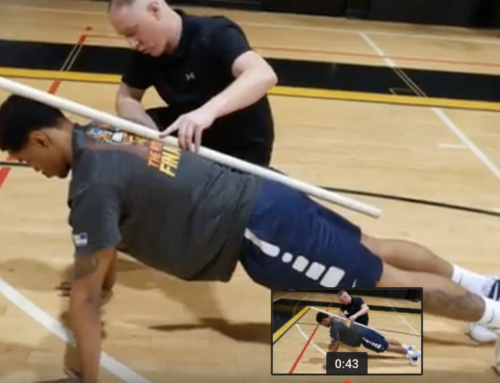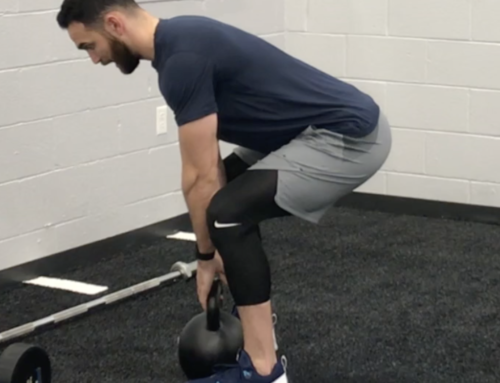Don’t Train Like The Pros!
By Ben Bruno, Professional Trainer
There is a big physical difference between high school basketball players and the professional athletes. The main difference is that the high schoolers are just growing into their height so they are not really used to their bodies. And since teenagers grow at different rates, the tendency is to throw the tall guys down low and make them center or power core. That whole issue gets tricky.
When these teens are growing into their bodies, they’re long-limbed and lanky. As a result, they usually don’t move well and can be awkward or clumsy. That’s part of what you are dealing with in their training. Because teenage athletes are often involved in various sports, I don’t necessarily train the high school basketball player specifically as a basketball player; I just train him as an athlete. That includes training in movement patterns such as split squat, upper-body pressing, chin-ups, planks and things of that nature. These may be harder for a taller teen-age athlete but that said, it’s not an excuse to do those things poorly.
Coaches may use an athlete’s height as a reason to not demand the same sort of form or range of motion as a shorter athlete. However, it’s very important to work towards that for the taller athlete, even though it may be challenging and takes more coaching. It’s a job – we are paid to do that.
Hip and ankle mobility are important. Almost every basketball player I’ve trained comes to the first workout in basketball sneakers. Whether the players are high school, college or pro, the first thing I tell them is to stop wearing their basketball sneakers in the gym. Anyone who lives in high-tops like that tends to have restricted ankle mobility, which can affect squatting, dead-weight patterns such as single-leg work, and also hip mobility. In developing a good squat pattern or a good split-squat pattern, the prescription is the same for the tall player as it is for anyone else; again, it’s just sometimes a little bit tougher.
A good way to start is doing simple splits, squats, isometric holds and holding, and also encouraging a full-range motion in the sport. I like to start people from the bottom position with isometric holds rather than starting from the top; then they don’t have an excuse to go only part way down.
When they move to normal reps, still starting in the bottom, just put a pad below the rear knee; when they start in that position, they end in that position. Remember that with squatting you can’t always expect perfection from the beginning; you’re not going to get a rock-bottom squat, for example. But if you work on good mobility, if you are a good coach and you demand good technique, you can get people to squat to parallel, or at least really close.
That might not happen on day one, so in the interim it’s probably not safe to demand that people go low, especially under a load. But when you’re trying to ingrain good movement patterns, the emphasis should be on a range of motion as opposed to loading a partial range of motion, especially in the beginning.
I started off doing group training and now I do personal training. The way I approach things has actually changed quite a bit because there are certain things that you can do in group training that you can’t do in personal training and vice versa. We always have to remember that our situation dictates our approach. The techniques I use now are geared to one-on-one personal training at this point since I work almost exclusively with individuals. When I recently trained a group of three athletes, the approach was different.
When you are group training, it’s obviously harder to individualize, but it’s important to do so as much as possible. The split squat is very challenging for some people and if it is, they basically need to practice and master it before moving on. Other people may find it difficult to master a different set. That’s the joy of personal training: You know after one set if a person can do it and then you just keep moving, whereas someone else might need three weeks of training for the same set.
There’s a concept in group training that sounds bad, but it’s not meant to be disrespectful or offensive. You program for the lowest common denominator, for the worst person in the group. That sounds derogatory but I believe you understand what I’m trying to say. I think you’re always better off in a group of high schoolers that are growing into their bodies and growing quickly.
By and large they’re going to need more ankle mobility and more hip mobility. They’re going to struggle with certain exercises for core stability and hip stability – split squat hold, for example. You can include those exercises in the program for your worst-case athlete scenario; adding a hip mobility exercise into the mix is not going to hurt those who already have pretty good hip mobility. At worst it might be a little bit of wasted time, meaning just a couple of minutes.
You can include the exercises that everyone needs in your program – but remember that what sounds good on paper may not be realistic. With high school students, you’re never going to have perfect circumstances, such as a long period of time for training. If you put everything you read about into your program, it would be an hour-and-a-half workout!
In reality you work with people for only 35-40 minutes so you have to choose the most important things. Sometimes the sessions I do now are 30-40 minutes and if I were to show you the workout I gave to a client on paper, you would think there are a lot of holes – and there are, but it’s because you can only fit so many things into that short amount of time.
Those who have worked as a trainer for several years can look back and realize they haven’t done certain exercises for a while because they got started on something else – maybe goblet squats. You can’t include everything, so when you’re training high school athletes and don’t have a lot of time, you have to follow the big rocks analogy: Choose your big rocks and know that you can’t hit everything but you have to hit the most important things. For example, I start every workout with lower body. I always do lower to upper so if a person normally comes in four times a week but misses today, it’s upper body tomorrow.
Often I work in pairings and tend to program two, three or four exercises into each pairing just to save time. That first exercise is always lower body, partially to let people know what I think is most important, and partially because we did the most important things if the workout time is cut short. For an athlete, those things include squatting, foot squatting, deadlifting, lunging, etc.
Often when high schoolers come in to work out, they’ve just come off the court. If they come to me directly from practice in any sport and we only have 30 minutes, my warm-up is a couple minutes at most and we just lift – they’re already warm. That said, I use mobility fillers. There are several exercises in each pairing: two, three or four, depending on the group size, the time and how crowded the gym is.
You can split people into two groups, using two exercises and rotating back and forth; it could be three, it could be four. That’s a good way to put mobility into the workout so you’re not wasting a lot of time warming up. Full range-of-motions/strength work really helps mobility also: A well-executed goblet squat checks a lot of boxes regarding strength, hip mobility and ankle mobility. That’s important to remember! (Pro athletes have a lot of mileage on their bodies so their warm-up and recovery protocols are much more involved.)
For more information on Ben, make sure to check out his website and sign up to receive his great training information: http://benbruno.com!







Leave A Comment